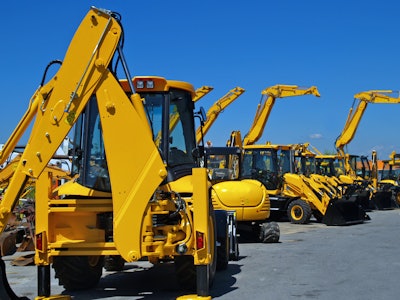
The construction market is still going strong, and for business owners, that means renting, leasing or buying additional equipment to match project needs. When making large purchase decisions, factors like machine utilization, cash flow, financing options, interest rates, economic fluctuations and inflation should be considered.
Low interest rates or lease-to-own options can make financing more attractive and help contractors keep more cash in hand. According to the Equipment Leasing and Financing Association, real private investment by U.S. businesses in equipment and software is forecast to be almost $2 trillion in 2022.
The organization, which represents the nearly $1 trillion equipment finance sector, recently released its top 10 equipment acquisition trends for 2022. Contractors and dealers can use these trends to better understand the market environment as they make plans to buy and sell equipment.
“The pandemic is the underlying theme throughout the trends this year as equipment acquisition continues to drive supply chains across all U.S. manufacturing and service sectors,” says ELFA President and CEO Ralph Petta. “Nearly eight in 10 of U.S. businesses use equipment leasing and financing to acquire the productive assets they need to operate and grow.”
After distilling recent research, data and member input, ELFA anticipates the following equipment leasing and financing trends for the year.
1. The U.S. economy will have solid growth in 2022. After a highly volatile 2021, the economy is on more even footing this year. The potential for economic growth later in the year is substantial with 3.5% GDP growth forecast for 2022.
2. Equipment shortages will continue due to supply chain disruptions. Delivery bottlenecks will likely persist, especially if U.S. trading partners shut their borders in response to new virus strains. Businesses will be likely to invest more capital in maintaining inventories of crucial components and develop relationships with new suppliers to reduce the impact of future disruptions.
3. High inflation will be a major headwind for Main Street and the overall economy. In fall 2021, supply chain snags added to inflationary pressures, which will be prolonged this year. The Federal Reserve has announced several planned interest rate hikes in 2022. It remains to be seen what impact, if any, interest rate increases will have on supply or demand.
4. Positive growth in capital spending will continue. Equipment and software investment expanded by more than 15% annualized from January to June 2021, which was comparable to the rapid growth after the Great Recession. With continued, though not as strong demand, equipment and software investment growth of 4.6% is expected.
5. Equipment finance will play a significant role in economic growth. Based on historical precedent, more than half of equipment and software investment this year will be financed. In addition, inflationary pressures that drive equipment prices higher will make financing more desirable with payments spread out over time.
6. Government fiscal and regulatory policies will pose opportunities and challenges to capital spending. Businesses will need to stay informed on a range of federal and state policy changes that will impact their operations. They include the long-awaited infrastructure spending law enacted by Congress that will have businesses investing in related equipment verticals, and federal and state initiatives that will create more red tape for lenders along with associated costs to borrowers.
7. Pandemic-driven changes in the workplace will continue to impact equipment demand. Ongoing remote/hybrid work arrangements will drive demand for new types of equipment and software as businesses continue to adapt to the “new normal.” Automation and AI technologies such as robotics, machine learning and natural language processing will boost the productivity of employees working remotely and fill the void of unavailable labor.
8. Many key equipment types will show growth. While equipment and software investment should expand at a healthy rate, growth is likely to be uneven across equipment verticals. Trucks, oil and gas equipment, and materials handling equipment should benefit from sustained demand. Verticals such as automobiles, construction machinery and agricultural equipment may continue to face pandemic-related headwinds such as input shortages, high energy prices and volatile demand conditions.
9. Businesses will increase their focus on digitization and data. As investment in digitization accelerates across most industries, businesses will need to leverage both customer and external data for competitive advantages in areas such as customer behavior and market dynamics. Cybersecurity risks will require increasingly robust cyber- and data-security protocols to be implemented.
10. “Wild cards” will play a role in business investment decisions. There are other areas in addition to the trends above that businesses will keep an eye on that could impact their equipment acquisition strategies. Continued fallout from the pandemic and future variants, ongoing labor shortages, passage of the “Build Back Better” spending package in Washington, and mid-term elections could all have potential business impacts.
 The Equipment Leasing and Finance Association represents the nearly $1 trillion equipment finance sector.Equipment Leasing and Finance Association
The Equipment Leasing and Finance Association represents the nearly $1 trillion equipment finance sector.Equipment Leasing and Finance Association













